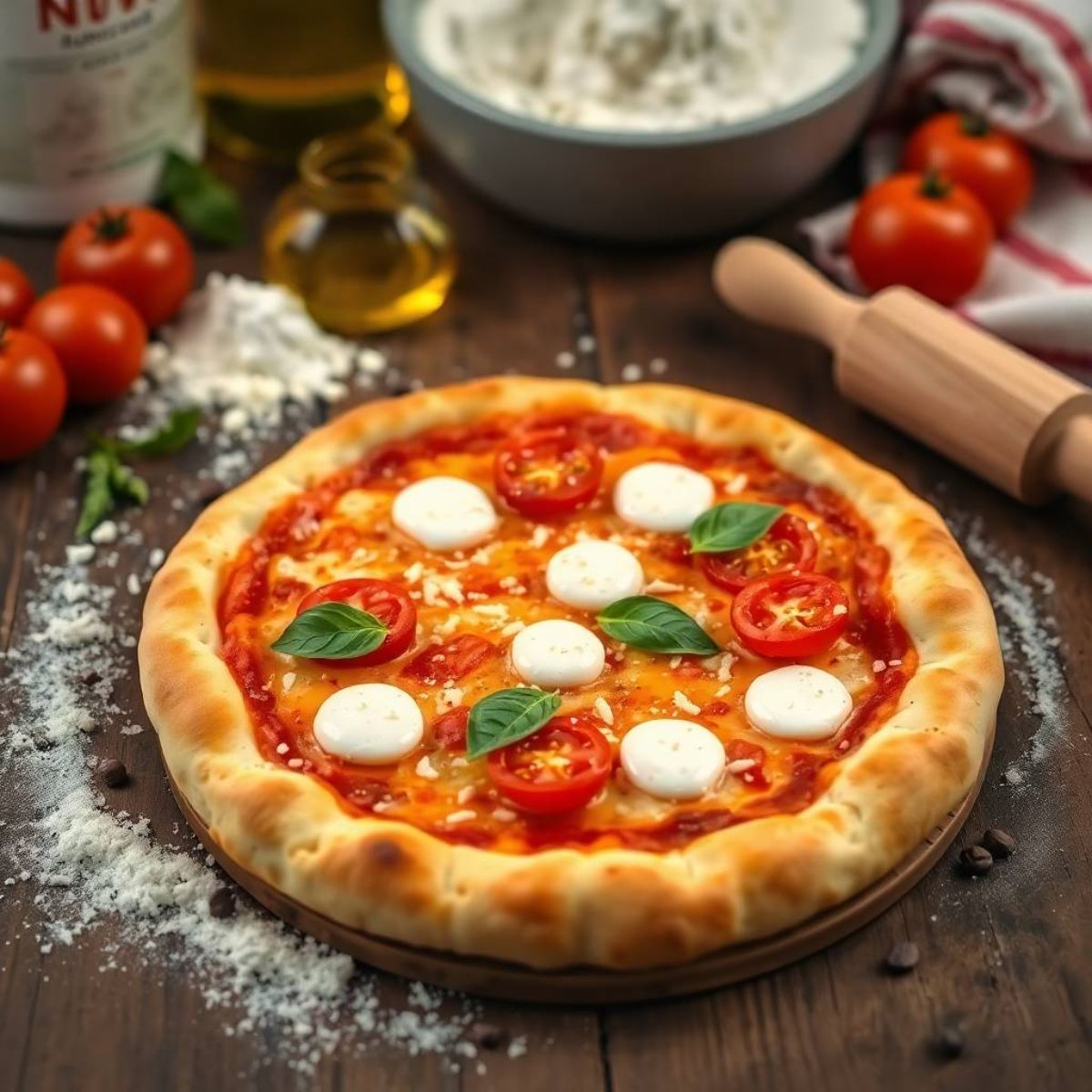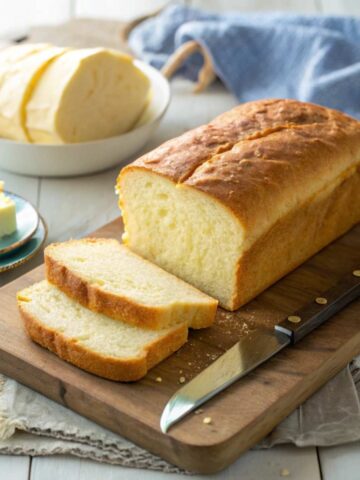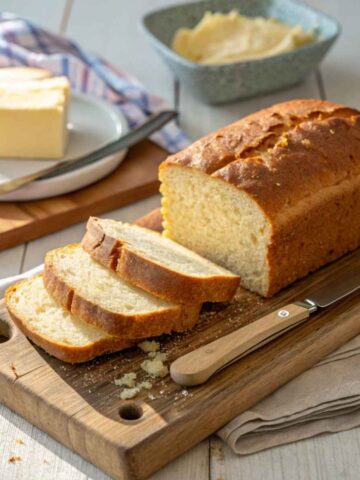Pizza is more than just food—it’s a way of life for many people. Pizza is one of those universally loved dishes, whether it’s a Friday night treat, a family dinner, or a quick snack. But if you’re gluten-free, enjoying pizza without worrying about gluten can be tricky. That’s where this guide comes in! We’ll show you how to make the perfect gluten free pizza crust that’s crispy on the outside, chewy on the inside, and just as satisfying as the real thing.

Jump to:
- What is Gluten, and Why Avoid It?
- The Basics of gluten free pizza crust
- Choosing the Right Gluten-Free Flour
- Key Ingredients for a Perfect gluten free pizza crust
- How to Make Gluten-Free Pizza Dough
- Tips for Rolling Out Gluten-Free Dough
- Creative Variations of gluten free pizza crust
- How to Achieve a Crispy Gluten-Free Crust
- Baking gluten free pizza crust to Perfection
- Gluten-Free Pizza Topping Ideas
- How to Store and Freeze gluten free pizza crust
- Is gluten free pizza crust Healthy?
- Common Mistakes to Avoid
- Conclusion
- FAQs
What is Gluten, and Why Avoid It?
The Role of Gluten in Traditional Pizza Dough
Gluten is a protein found in wheat, barley, and rye. It gives traditional pizza dough its elasticity and chewiness. When mixed with water, gluten forms a stretchy network that traps air, allowing the dough to rise and giving it structure.
Why People Follow Gluten-Free Diets
People with celiac disease, non-celiac gluten sensitivity, or a wheat allergy must avoid gluten to prevent digestive distress, inflammation, or other symptoms. For these individuals, following a gluten-free diet is essential for managing their health. Even for those without gluten-related issues, going gluten-free can be a dietary choice to reduce inflammation or for personal wellness reasons.
The Basics of gluten free pizza crust
Critical Differences Between Gluten-Free and Traditional Pizza Crust
The most significant difference between gluten-free and traditional pizza dough is the lack of gluten, which means gluten-free dough won’t stretch or rise the same way. gluten free pizza crust tends to be more delicate and less elastic. However, you can still achieve a chewy and crispy crust that rivals traditional versions with the right ingredients.
How Gluten-Free Doughs Behave Differently
Without gluten, gluten-free doughs are usually more fragile and sticky, making them harder to work with. However, using a combination of gluten-free flour and binders can help mimic the structure that gluten provides. gluten free pizza crusts often require pre-baking to ensure a crispy texture before adding toppings.
Choosing the Right Gluten-Free Flour
The type of gluten-free flour you use will significantly impact the texture and flavor of your pizza crust. Here are some popular gluten-free flours to consider:
The Best Gluten-Free Flour Blends for Pizza
Many pre-made gluten-free flour blends are formulated to mimic wheat flour, providing the perfect balance of starches and proteins. Look for a blend that includes:
- Rice flour
- Potato starch
- Tapioca starch These ingredients help create a smooth, elastic dough that bakes into a crisp crust.
Almond Flour, Rice Flour, and Other Alternatives
If you prefer to mix your flour, consider using almond flour for a nutty flavor or rice flour for a neutral taste. Both flours add texture and flavor, while tapioca starch can add chewiness to the crust. Mixing xanthan gum or psyllium husk is often used as a binder to help the dough hold together.
Key Ingredients for a Perfect gluten free pizza crust
The perfect gluten-free pizza dough requires the right blend of ingredients to achieve the best texture and flavor.
Flour Blend, Yeast, and Baking Powder
The base of any pizza dough is flour, but for gluten-free dough, you also need to add binders like xanthan gum and a leavening agent like baking powder or yeast to help the dough rise. Yeast is often used for a more traditional pizza crust while baking powder works for a quicker, no-rise dough.
Eggs or Flaxseeds as Binders
Eggs or egg substitutes like flaxseed meal (combined with water) help give gluten-free pizza dough its structure. This prevents the dough from crumbling and allows it to hold together when baked.
Adding Moisture with Olive Oil
Olive oil adds moisture to the dough and helps it brown nicely during baking. It’s an essential ingredient for achieving a golden, crispy crust.
How to Make Gluten-Free Pizza Dough
Making gluten-free pizza dough is simple with these step-by-step instructions:
- Mix the Dry Ingredients: In a large bowl, combine your gluten-free flour blend, baking powder or yeast, xanthan gum (if not already in your flour blend), and salt.
- Add Wet Ingredients: Add warm water (or milk), olive oil, and eggs (or flaxseed mixture) to the dry ingredients. Mix until a sticky dough forms.
- Let it Rest: Let the dough rest for 10-15 minutes to allow the flour to absorb the liquids. This will help improve the dough’s texture and make it easier to work with.
Tips for Rolling Out Gluten-Free Dough
Handling Sticky Dough: Best Techniques
Gluten-free dough is often stickier than traditional dough, making it challenging to roll out. Here are some tips for working with gluten-free pizza dough:
- Use Parchment Paper: Place the dough between two sheets of parchment paper and roll it out with a rolling pin. This prevents sticking and makes transferring the dough to the baking sheet easier.
- Flour Your Hands: Dust your hands with gluten-free flour to prevent the dough from sticking to your fingers.
How to Avoid Overworking the Dough
Overworking gluten-free dough can lead to a rigid or crumbly crust. Handle the dough gently and avoid kneading it too much. Since there is no gluten to develop, gluten-free dough doesn’t need as much mixing as traditional dough.
Creative Variations of gluten free pizza crust
One of the best things about gluten free pizza crust is its versatility. Here are some creative alternatives to the classic flour-based dough:
Cauliflower Pizza Crust
Made with grated cauliflower, eggs, and cheese, cauliflower crust is a low-carb, gluten-free option packed with nutrients. It’s perfect for those looking to add more vegetables to their diet.
Almond Flour Pizza Crust
Almond flour adds a rich, nutty flavor to pizza crust and is an excellent option for those who want a grain-free, gluten-free crust. It’s higher in protein and healthy fats than traditional flours, making it more filling. Almond flour pizza crust tends to be softer and more tender, perfect for those who enjoy a slightly crumbly texture.
Vegan gluten free pizza crust
Suppose you're avoiding gluten and animal products. In that case, you can make a vegan, gluten free pizza crust using a combination of gluten-free flour, water, olive oil, and a flaxseed meal (as an egg replacement). This option is perfect for those who want to enjoy a pizza night without compromising dietary restrictions.
How to Achieve a Crispy Gluten-Free Crust
One of the critical challenges when making gluten free pizza crust is getting it to be crispy. Here’s how you can achieve the perfect crunch:
Using Parchment Paper or Pizza Stone
Baking your pizza crust on a pizza stone helps distribute heat evenly, ensuring the crust becomes crispy. If you don’t have a pizza stone, use parchment paper to line your baking sheet. This prevents sticking and helps create a crisp bottom.
Baking at High Temperatures for Crispiness
Baking your pizza at a higher temperature, such as 450°F (230°C), helps the crust become crispier. Gluten-free dough needs more heat than regular dough, so ensure your oven is fully preheated.
Baking gluten free pizza crust to Perfection
Pre-Baking the Crust Before Adding Toppings
To prevent sogginess, it’s essential to pre-bake your gluten free pizza crust before adding toppings. Bake the crust for 10-12 minutes, then remove it from the oven, add your toppings, and continue baking until the cheese is bubbly and the crust is golden.
How Long to Bake for the Perfect Balance of Crisp and Chew
The total baking time for a gluten free pizza crust is usually around 20-25 minutes. After pre-baking the crust, return it to the oven with toppings for 10-15 minutes. You can bake the pizza for a few extra minutes at the end for an extra crispy texture.
Gluten-Free Pizza Topping Ideas
Now that you’ve perfected your crust, it’s time to think about toppings! Here are a few ideas for your gluten-free pizza:
Classic Margherita
Top your gluten-free crust with tomato sauce, mozzarella, basil, and a drizzle of olive oil for a simple, fresh pizza. This classic pizza is light yet full of flavor.
Meat Lovers
If you’re craving something hearty, load your pizza with gluten-free pepperoni, Italian sausage, bacon, and ground beef. Add shredded mozzarella and a tomato base for a filling and satisfying meal.
Veggie-Packed Pizza
For a healthier option, choose a variety of vegetables, such as bell peppers, onions, mushrooms, spinach, and olives. Top it off with some feta or goat cheese for added flavor.
Want more quick and easy gluten-free meal ideas? Check out our Gluten-Free Fast Food Options for inspiration!
How to Store and Freeze gluten free pizza crust
Best Ways to Store Leftover Dough or Pre-Baked Crusts
You can store leftover gluten-free pizza dough in the fridge for up to 3 days. Make sure to wrap the dough tightly in plastic wrap or store it in an airtight container. You can also pre-bake the crust and store it in the fridge for a quick meal later.
Tips for Freezing and Reheating Without Losing Quality
gluten free pizza crust freezes well, whether raw or pre-baked. To freeze, wrap the dough or pre-baked crust in plastic wrap and place it in a freezer-safe bag. When ready to use it, let it thaw overnight in the fridge and bake as usual. For best results, reheat the crust in a preheated oven to maintain crispiness.
Is gluten free pizza crust Healthy?
Nutritional Comparison Between Gluten-Free and Traditional Pizza Dough
gluten free pizza crust can be just as healthy (or healthier) than traditional crust, depending on the ingredients used. Some gluten-free flours are higher in fiber, vitamins, and minerals than refined wheat flour. However, gluten-free crusts may contain more calories if made with almond flour or cheese.
How to Make Your Pizza Crust Healthier with Whole Ingredients
To make your gluten free pizza crust healthier, use a blend of whole-grain gluten-free flour such as brown rice flour, quinoa flour, or buckwheat flour. You can also reduce the amount of oil or add seeds like chia or flax for extra fiber and nutrients.
Looking to expand your gluten-free baking repertoire? Master the art of Gluten-Free Puff Pastry for indulgent, flaky delights.
Common Mistakes to Avoid
Overworking the Dough
Gluten-free dough is more delicate than traditional dough, so avoid overworking it. Kneading too much can make the crust tough and dry. Instead, gently combine the ingredients and handle the dough as little as possible.
Not Pre-Baking the Crust
If you skip the pre-baking step, you risk a soggy crust, especially when adding sauce and toppings. Always pre-bake the crust for 10 minutes before adding toppings to ensure a crispy base.
Want to try another staple recipe? Check out our Gluten-Free Bread Recipe—perfectly soft and delicious for any occasion.
Conclusion
Making a delicious, crispy, gluten free pizza crust is easier than it may seem. You can create a pizza that rivals any gluten-containing version with the right ingredients, techniques, and patience. From choosing the best gluten-free flour to mastering the art of pre-baking, this guide has provided you with all the tips and tricks you need to enjoy homemade pizza night without gluten.
Whether you prefer a classic Margherita pizza, a veggie-packed delight, or a meat lover’s special, gluten-free pizza, it is versatile and customizable to suit your tastes. Try different variations, and don’t be afraid to experiment with new flavors and toppings!
FAQs
Yes! You can make a no-yeast gluten free pizza crust using baking powder as the leavening agent. While the crust won’t have the same airy texture as a yeast-based dough, it will still rise slightly and produce a delicious, crispy base.
To prevent your pizza crust from crumbling, use a binder like xanthan gum, psyllium husk, or eggs. These ingredients help hold the dough together and give it structure.
Yes! Gluten-free pizza dough freezes very well. Just wrap it tightly in plastic and place it in a freezer-safe bag. Thaw it in the refrigerator before using it, and bake as usual.
A gluten-free flour blend that includes rice flour, tapioca starch, and potato starch works best for pizza dough. These flours create a balance of lightness and chewiness, similar to traditional pizza crusts.
If you’re using yeast in your gluten-free pizza dough, let it rise for about 30 minutes in a warm, draft-free place. This helps lift the dough and improves its texture.





Leave a Reply